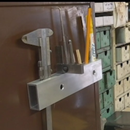Introduction: The Trash Garden (a Zero Cost, Easy Raised Bed)
As an entry into the gardening contest i decided to build something iv'e been concocting for a number of years now. Following on from a book i remember reading nearly 10 years ago by a similar title (i can't quite remember it all) about building gardens out of what you have in your community.
This is known as a lasagne garden which in itself is an evolution of Ruth Stouts gardening method. To sum it up its basically layers of mulch for the plants to grow through, as the mulch break down to release nutrients for the soil you simply add more on top.
This design goes a few steps further again
- A large volume of good quality soil in a very small footprint
- An incredible ability to hold the water for the plants to obtain
- Can be placed anywhere, even on concrete
- FREE!!!
Step 1: Collect Your Materials.
I find it best to collect your materials all in one place before starting a project.
consumables
- 4 pallets, try and use the same size but really anything will work
- cardboard, lots and lots of cardboard
- Mulch or high carbon material
- manure or high nitrogen material
- string or wire
- Plants
Tools
- Shovel
- Knife
- watering can
You should be able to find all the materials you need anywhere around you. If not adapt to what you do have.
Pallets are often free for the taking. For me i got mine from the local hardware centre, standard pallets they send back but the non-standard, halfs or over sizes are left for people to take.
My cardboard came from the large recycling bins opposite my dads business. The other business' pay to have it taken away so as long as you keep it neat they don't mind what you take. Try and steer clear of very glossy boxes, some of these have a plastic layer over the top of the cardboard.
Mulch materials can come from a lot of sources. Leaves of all sorts are really all you need, these can be collected all at once in the Fall or raked up from under trees. Straw or hay is another good option, dry lawns can be if you can cut them long we don't want the material matting down. Do not use paper or cardboard for the bulk of material, it will matt down and not allow our plants roots to easily pass through them until broken down.
While Iv'e called it manure its better to call it high nitrogen layers as it includes things like fresh lawn clippings and food waste. You can collect these from simply asking people when they mow their lawn, have a chat to the local green grocer. Also have a chat to your local veterinarian, if you drop of a bin it will be full in no time. The more adventurous could choose to soak the area liberally in urine, whatever floats your boat.
Step 2: Caution: Cleaning Your Cardboard
WARNING!!
When opening your boxes, or cleaning the tape off them be careful of any staples. They are very sharp and will cause severe trauma to your fingers, I know a number of people who have required stitches due to them.
Wear gloves and use a pair of pliers when removing them.
Step 3: Choose and Clear Your Site
I decided to use this area behind my two water tanks. It faces west which may cause some issues in the australian summer, but should be perfect for winter time. It was levelled to have more water tanks putin, which we never got around to. The ground is compacted rubble so there is no use in digging down to build a new garden bed, and a normal low raised bed will just cause issues if i ever plan to remove it for more tanks.
Try and choose a site that gets the afternoon sun but is sheltered from cold winds. You don't need to worry about the soil below the garden with this design, you could build it on a driveway if you wished.
I cleared some of the wild olive trees that were growing here to get better access, make sure that the base is somewhat level for your pallets to sit on.
Step 4: Building the Frame
Now we know where its going we just need to build the frame.
The frame is simply 4 pallets tied together to form a square. I chose to lace mine together with bailing twine but wire would possibly be better after a few years of use. If your doing this on soil hammering some pegs in the corners would also be a good idea to help support it
Step 5: Lining the Frame
Now we need to line the fram witht the cardboard. If using pallet like i am you need to line the side of the frame too, this stops the water and soil getting out through the gaps. A single layer on the sides should be enough, once plants are growing in the soil they will help hold it all together as well.
I used a single solid layer on the bottom (apart from the remainse of the olive tree) and then covered the rest with more layers of loos cardboard. I also added more to sides on the inside of the pallet.
The aim of the cardboard here is to stop weeds coming up from the ground underneath and to absorb water like a sponge. This water is available for the plants as well as making a perfect spot for out friends the worms and other insects. You can see more of its effects later in the ible.
Step 6: Layer Time
It doesn't get much simpler than this.
Dump your first layer of mulch material in, i went to about 10 inches deep. Don't compact it, we want it to be nice and fluffy. Next throw in your layer of manure or greens. spread it out to about 1 inch deep. because i used dog poop for this layer I decided to go with a thick layer of paper, this again will slow the water going through but it also meant that if I'm harvesting anything in the next few months I don't want to go much deeper.
From here its a matter of just adding your layers, like a lasagne. A layer of mulch and then a layer of manure, water the manure layers very well to help start activating the break down process. I built mine with approximately 7 layers with the last being mulch.
Step 7: Planting Out
Now comes the most imporant part of gardening.
Getting your plants into the ground. Ive chosen to put some Sweet potato/yams in this bed. Its just a matter of putting them in, and giving them a drink.
When using a lasagne garden I like to keep a put more mature seedlings in, this allows for a faster take off and more soil around the roots. I won't be using seeds in these beds because of the large air pore size, if you use smaller mulch you might have better results.
Step 8: The Differences
Heres a bit of a display of the cardboard on my two main beds that have been converting over to Ruth Stouts method.
I started laying straw on them at the same time, they both get the same amount of water.
The differece is one bed was covered In cardboard and then straw, the plants were then planted directly in. The other already had pumpkin and sweet potato in so I didn't pull them up to put cardboard down. The difference is amazing, under the straw the cardboard is constantly wet, the roots of the beans intertwine and run along it, worms and bugs scurry around. The dirt straight under the straw though, its dry and dead, I couldn't find a single worm. Now there are some

Participated in the
Gardening Contest










